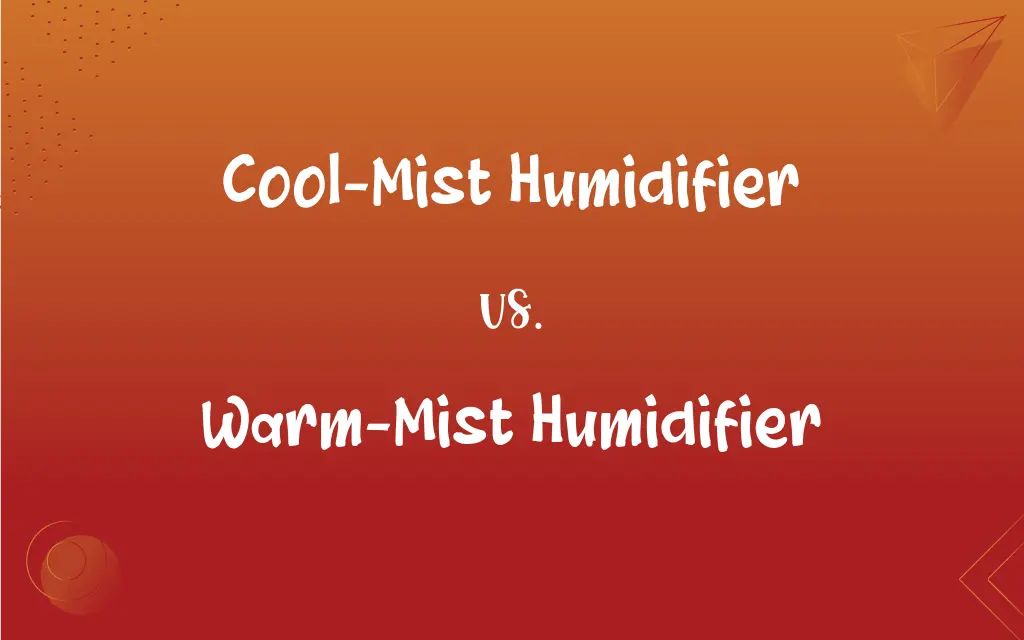Cool-Mist Humidifier vs. Warm-Mist Humidifier: What's the Difference?
Edited by Aimie Carlson || By Janet White || Published on March 4, 2024
Cool-mist humidifiers emit water vapor at room temperature, while warm-mist humidifiers release steam by boiling water.

Key Differences
Cool-mist humidifiers and warm-mist humidifiers serve the same purpose: to add moisture to the air. However, the method of humidification differs significantly between the two. Cool-mist humidifiers disperse a room-temperature mist, making them suitable for use year-round, especially in warmer climates. They work either through ultrasonic vibrations or by using a wick filter and fan. Warm-mist humidifiers, on the other hand, boil water to produce steam, which cools slightly before leaving the humidifier as a warm mist. This process can help warm the room slightly, making these humidifiers ideal for colder climates.
The choice between a cool-mist humidifier and a warm-mist humidifier often depends on personal preference and specific needs. Cool-mist humidifiers are generally considered safer for use in children's rooms because they do not have a heating element that could pose a burn risk. Warm-mist humidifiers may be preferred by those seeking relief from cold or respiratory symptoms, as the warm steam can help soothe throat and nasal passages.
Maintenance and operation costs also vary between the two types. Cool-mist humidifiers, especially evaporative types, require regular cleaning to prevent mold and bacteria growth on the wick. Warm-mist humidifiers need to be cleaned to avoid mineral buildup from boiled water, but they typically do not have filters that need replacing. The energy consumption of warm-mist humidifiers is usually higher due to the boiling process.
In terms of health benefits, both types of humidifiers can help alleviate symptoms of dry air, such as dry skin, irritated nasal passages, and static electricity. However, warm-mist humidifiers can offer additional comfort to those suffering from colds or flu by providing warm moisture that can help loosen congestion. Cool-mist humidifiers are better suited for adding moisture without changing the room temperature.
The noise level is a consideration. Cool-mist humidifiers, particularly ultrasonic models, are known for their quiet operation, making them ideal for bedrooms. Warm-mist humidifiers can have a slight gurgling or boiling sound, which some may find soothing, but others may find disruptive.
ADVERTISEMENT
Comparison Chart
Operation Temperature
Room temperature vapor
Boils water to produce warm steam
Safety
Safer around children; no hot parts
Hot steam and surfaces; burn risk
Maintenance
Requires regular cleaning; filter changes for some types
Requires descaling; generally no filters
Energy Consumption
Lower, except for ultrasonic models which can be higher
Higher due to boiling water
Best Use
Year-round, especially in warmer climates
Colder months or for cold relief
ADVERTISEMENT
Noise Level
Quiet, especially ultrasonic models
May produce boiling or gurgling sounds
Cool-Mist Humidifier and Warm-Mist Humidifier Definitions
Cool-Mist Humidifier
Known for quiet operation, making it suitable for bedrooms.
The cool-mist humidifier ran so quietly, it never disturbed his sleep.
Warm-Mist Humidifier
Warm steam can soothe throats and ease congestion.
She always used a warm-mist humidifier when she had a cold.
Cool-Mist Humidifier
Uses less energy compared to warm-mist types.
To save on electricity bills, they opted for a cool-mist humidifier.
Warm-Mist Humidifier
Needs regular cleaning to remove mineral buildup.
He descaled his warm-mist humidifier to maintain its efficiency.
Cool-Mist Humidifier
A device that increases air moisture without warming it.
She used a cool-mist humidifier to combat dry air in her apartment.
Warm-Mist Humidifier
May emit a boiling sound during operation.
The gurgling of the warm-mist humidifier was a soothing nighttime sound.
Cool-Mist Humidifier
Requires maintenance to prevent mold.
He cleaned his cool-mist humidifier weekly to keep it hygienic.
Warm-Mist Humidifier
Consumes more electricity due to heating element.
Despite higher energy use, the warmth from the warm-mist humidifier was worth it.
Cool-Mist Humidifier
Emits vapor without using heat, reducing burn risks.
Their cool-mist humidifier was chosen for safety in the nursery.
Warm-Mist Humidifier
Heats water to create steam for humidification.
The warm-mist humidifier provided a comforting steam on cold nights.
FAQs
Which type of humidifier is quieter?
Cool-mist humidifiers, especially ultrasonic models, are quieter.
Which is safer for a child's room, cool-mist or warm-mist?
Cool-mist is safer due to the absence of hot water and surfaces.
Are there filter-free cool-mist humidifiers?
Yes, ultrasonic cool-mist humidifiers often do not require filters.
How often should I clean my cool-mist humidifier?
It should be cleaned regularly, at least once a week.
Is a warm-mist humidifier good for all year round?
It's best used in colder months or for those needing relief from colds.
Do cool-mist humidifiers use more energy than warm-mist?
Generally, no; warm-mist humidifiers typically use more energy.
Can warm-mist humidifiers help with cold symptoms?
Yes, the warm steam can soothe throat and nasal passages.
Can I use essential oils with my cool-mist humidifier?
This depends on the model; some ultrasonic humidifiers allow it.
What maintenance does a warm-mist humidifier require?
Regular descaling to remove mineral deposits is necessary.
Is it okay to leave a humidifier on all night?
Yes, if it has an auto-shutoff feature or is in a well-ventilated area.
Why does my warm-mist humidifier have a white residue?
This is likely due to mineral deposits from hard water.
How does a cool-mist humidifier work?
It uses a fan or ultrasonic vibrations to evaporate water into the air.
Do humidifiers help with allergies?
Yes, both types can help by adding moisture to the air, reducing allergen presence.
Does a warm-mist humidifier make the room warmer?
It can slightly increase the room temperature.
Can I use tap water in my cool-mist humidifier?
It's recommended to use distilled water to avoid mineral buildup and white dust.
Can cool-mist humidifiers cool down a room?
They do not significantly change the room temperature.
What's the best water to use in a warm-mist humidifier?
Distilled or demineralized water is best to minimize mineral buildup.
Can I use a cool-mist humidifier in winter?
Yes, it can help combat the dry air from heating systems.
Do warm-mist humidifiers need a filter?
Most do not use a filter but require regular cleaning.
How do I choose between a cool-mist and warm-mist humidifier?
Consider safety, maintenance, noise, and personal health needs.
About Author
Written by
Janet WhiteJanet White has been an esteemed writer and blogger for Difference Wiki. Holding a Master's degree in Science and Medical Journalism from the prestigious Boston University, she has consistently demonstrated her expertise and passion for her field. When she's not immersed in her work, Janet relishes her time exercising, delving into a good book, and cherishing moments with friends and family.
Edited by
Aimie CarlsonAimie Carlson, holding a master's degree in English literature, is a fervent English language enthusiast. She lends her writing talents to Difference Wiki, a prominent website that specializes in comparisons, offering readers insightful analyses that both captivate and inform.







































































